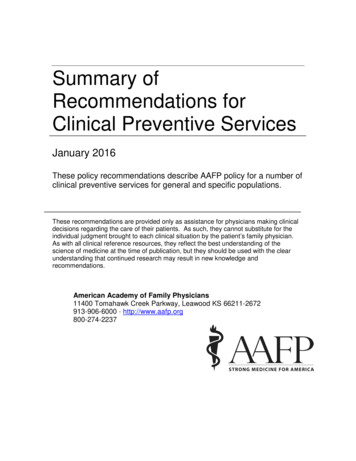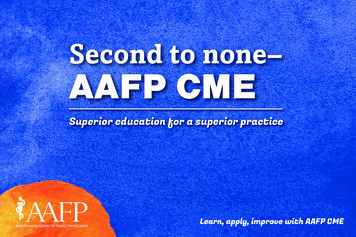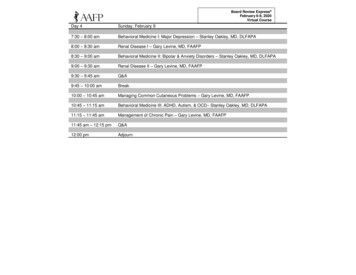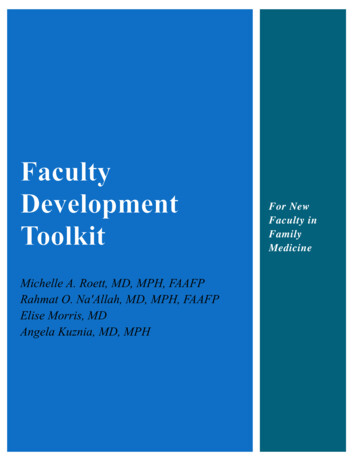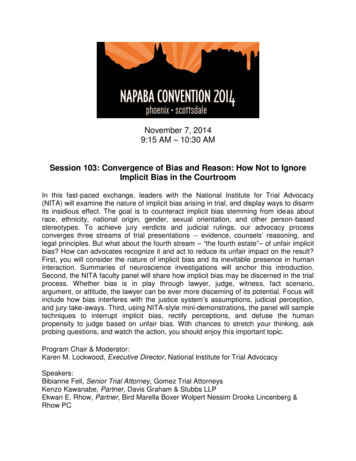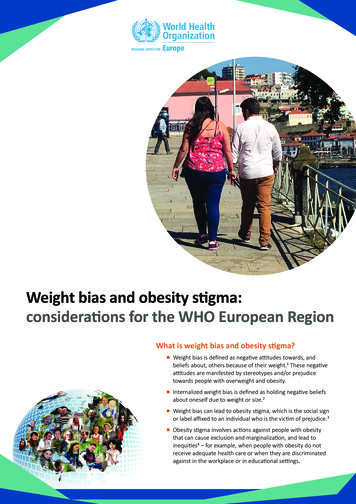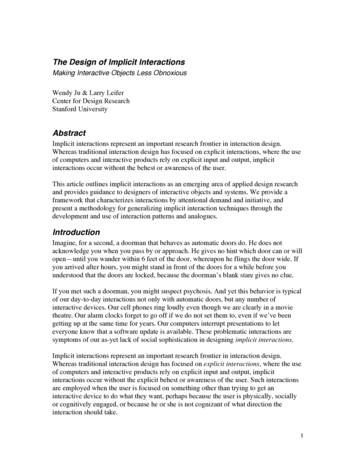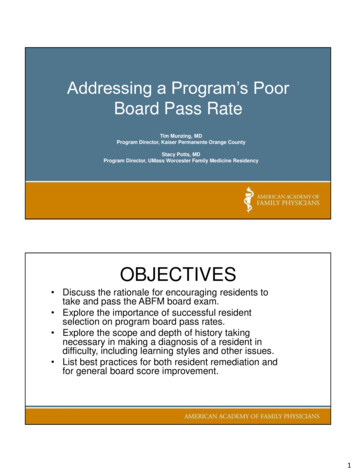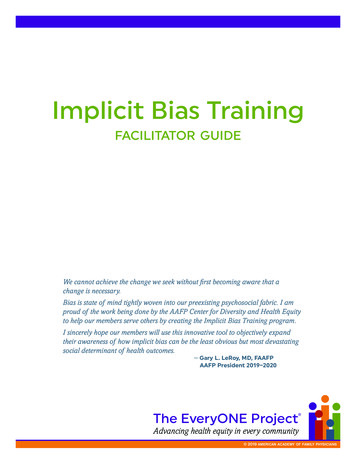
Transcription
Implicit Bias Trainingfacilitator guideWe cannot achieve the change we seek without first becoming aware that achange is necessary.Bias is state of mind tightly woven into our preexisting psychosocial fabric. I amproud of the work being done by the AAFP Center for Diversity and Health Equityto help our members serve others by creating the Implicit Bias Training program.I sincerely hope our members will use this innovative tool to objectively expandtheir awareness of how implicit bias can be the least obvious but most devastatingsocial determinant of health outcomes. – Gary L. LeRoy, MD, FAAFPAAFP President 2019–2020The EveryONE Project Advancing health equity in every community 2019 american academy of family physicians
The EveryONE Project Advancing health equity in every communityDISCLAIMERThe EveryONE Project materials are copyrighted, and The EveryONE Project is a registered trademark of theAmerican Academy of Family Physicians (AAFP). By downloading any of these materials, you agree that you will only useThe EveryONE Project materials for the purposes of education and advancing health equity. The EveryONE Project materialsmay not be modified in any way and may not be used to state or imply the AAFP’s endorsement of any goods or services.ACKNOWLEDGEMENTSThe AAFP would like to thank the following for contributing to the development of this training guide:AAFP Members and Chapter StaffLiza Brecher, MD; Scott Hartman, MD, FAAFP; Sarah McNeil MD, FAAFP; Andrea Westby, MD, FAAFPAnn Spicer, Executive Vice President, Ohio Academy of Family PhysiciansATW Health Solutions, Inc.PatientsRosie Bartel; Stephen T. Hale; Kyle SchuesslerCONTACT USIf you have questions regarding this training program or other diversity, health equity,and inclusion initiatives at the AAFP, please contact:Center for Diversity and Health Equity11400 Tomahawk Creek Parkway Leawood, KS 66211Office: (913) 906-6319healthequity@aafp.orgHOP19070915Supported in part by a grant from the AAFP Foundation 2019 american academy of family physiciansfacilitator guide page 1
The EveryONE Project Advancing health equity in every communitytable of contentsSection 1: Overview . . . . . . . . . . . . . . . . . . . . . . . . . . . . . . . . . . . . . . . . . . . . . . . . . . . . .Gaps in Medical Education. . . . . . . . . . . . . . . . . . . . . . . . . . . . . . . . . . . . . . . . . . . . . . . .The Need for Implicit Bias Training. . . . . . . . . . . . . . . . . . . . . . . . . . . . . . . . . . . . . . . . . . .Goals of Implicit Bias Training . . . . . . . . . . . . . . . . . . . . . . . . . . . . . . . . . . . . . . . . . . . . . .Learning Objectives . . . . . . . . . . . . . . . . . . . . . . . . . . . . . . . . . . . . . . . . . . . . . . . . . . . . .Standards of Conduct. . . . . . . . . . . . . . . . . . . . . . . . . . . . . . . . . . . . . . . . . . . . . . . . . . . .Framework. . . . . . . . . . . . . . . . . . . . . . . . . . . . . . . . . . . . . . . . . . . . . . . . . . . . . . . . . . . .Target Audiences. . . . . . . . . . . . . . . . . . . . . . . . . . . . . . . . . . . . . . . . . . . . . . . . . . . . . . .Learner Activity: Implicit Bias Pop Quiz . . . . . . . . . . . . . . . . . . . . . . . . . . . . . . . . . . . . . .334444566Section 2. Course Prework for Learners. . . . . . . . . . . . . . . . . . . . . . . . . . . . . . . . . . . . 7Learner Activity: Implicit Association Test. . . . . . . . . . . . . . . . . . . . . . . . . . . . . . . . . . . . . 7Learner Activity: Self-Evaluation Forms . . . . . . . . . . . . . . . . . . . . . . . . . . . . . . . . . . . . . . 7Section 3. Creating a Safe and Inclusive Learning Environment . . . . . . . . . . . . . . . 8Learner Activity: Identity Signs. . . . . . . . . . . . . . . . . . . . . . . . . . . . . . . . . . . . . . . . . . . . . 8Intersectionality Theory. . . . . . . . . . . . . . . . . . . . . . . . . . . . . . . . . . . . . . . . . . . . . . . . . . 10Section 4. Evidence of Implicit Bias . . . . . . . . . . . . . . . . . . . . . . . . . . . . . . . . . . . . . . . 11The Neuroscience of Implicit Bias. . . . . . . . . . . . . . . . . . . . . . . . . . . . . . . . . . . . . . . . . . . 11Implicit Bias and Patient Outcomes. . . . . . . . . . . . . . . . . . . . . . . . . . . . . . . . . . . . . . . . . . 12Section 5. Strategies to Mitigate Implicit Bias in Clinical Practice. . . . . . . . . . . . . 13Increasing Self-Awareness . . . . . . . . . . . . . . . . . . . . . . . . . . . . . . . . . . . . . . . . . . . . . . . 13Learner Activity: Denmark Kangaroo Orange. . . . . . . . . . . . . . . . . . . . . . . . . . . . . . . . . 13Learner Activity: Implicit Association Test Discussion. . . . . . . . . . . . . . . . . . . . . . . . . . . . 14Learner Activity: Social Perspective-Taking Surveys. . . . . . . . . . . . . . . . . . . . . . . . . . . . . 14Building Empathy. . . . . . . . . . . . . . . . . . . . . . . . . . . . . . . . . . . . . . . . . . . . . . . . . . . . . . . 14Video Activity: Building Empathy . . . . . . . . . . . . . . . . . . . . . . . . . . . . . . . . . . . . . . . . . . 15Video Activity: Observing Implicit Bias. . . . . . . . . . . . . . . . . . . . . . . . . . . . . . . . . . . . . . 15Practicing Mindfulness. . . . . . . . . . . . . . . . . . . . . . . . . . . . . . . . . . . . . . . . . . . . . . . . . . 15Activating Goals That Promote Fairness and Equality . . . . . . . . . . . . . . . . . . . . . . . . . . . . 16Learner Activity: Goal Activation . . . . . . . . . . . . . . . . . . . . . . . . . . . . . . . . . . . . . . . . . . 16Collecting Counter-Stereotypical Information. . . . . . . . . . . . . . . . . . . . . . . . . . . . . . . . . . . 17Learner Activity: Countering Stereotypical Information . . . . . . . . . . . . . . . . . . . . . . . . . . . 17Section 6. Case Studies. . . . . . . . . . . . . . . . . . . . . . . . . . . . . . . . . . . . . . . . . . . . . . . . . 18Case 1: Ashley . . . . . . . . . . . . . . . . . . . . . . . . . . . . . . . . . . . . . . . . . . . . . . . . . . . . . . . . 18Case 2: Tasha . . . . . . . . . . . . . . . . . . . . . . . . . . . . . . . . . . . . . . . . . . . . . . . . . . . . . . . . 19Section 7. Additional Reading. . . . . . . . . . . . . . . . . . . . . . . . . . . . . . . . . . . . . . . . . . . .References. . . . . . . . . . . . . . . . . . . . . . . . . . . . . . . . . . . . . . . . . . . . . . . . . . . . . . . . . . . . .Appendix A. Social Perspective-Taking Survey For Health Care Professionals. . . . . . . . . . . . .Appendix B. Social Perspective-Taking Survey For Medical Students and Residents. . . . . . . . 2019 american academy of family physicians21222324facilitator guide page 2
The EveryONE Project Advancing health equity in every communitySECTION 1: OverviewPLEASE NOTE:This section corresponds with the “Overview” PowerPoint presentation available online at www.aafp.org/implicit-bias.Implicit bias, defined as, “the attitudes or stereotypes that affect our understanding, actions, and decisions in anunconscious manner,” is a contributing factor to health disparities.1 Family physicians should make an effort to exploretheir own implicit biases so they can identify unconscious decisions and actions that may negatively affect the communitiesthey serve.Common types of implicit bias include the following2: Affinity – Preference for people who share qualities with you or someone you like Anchoring – Tendency to rely too heavily on the first piece of information offered when you are making decisions Attribution – Tendency to attribute other people’s successes to luck or help from others and attribute their failuresto lack of skill or personal shortcomings Beauty – Assumptions about people’s skills or personality based on their physical appearance and tendency tofavor people who are more attractive Confirmation – Selective focus on information that supports your initial opinion(s) Conformity – Tendency to be swayed too much by the views of other people Contrast – Assessment of two or more similar things by comparing them with one another rather than looking attheir individual merits Gender – Preference for one gender over the other Halo – Focus on one particularly positive feature about a person that clouds your judgement Horns – Focus on one particularly negative feature about a person that clouds your judgementThe American Academy of Family Physicians (AAFP) recommends educating physicians about implicit bias and strategiesto address it to support culturally appropriate, patient-centered care and reduce health disparities.1Gaps in Medical EducationResearch has shown that implicit bias is pervasive among all health care professionals and has deleterious effectson patient health.3 However, formal medical education and training curricula are often void of content that provides aframework for identifying and mitigating implicit bias in clinical practice. Faculty who actively seek to incorporate this topicin training often face barriers, such as a limited number of subject matter experts who can provide instruction.4,5 Healthcare professionals also lack opportunities to demonstrate bias mitigation strategies in practice or to engage with patientswho can share experiences of encountering implicit bias in clinical settings.4,6,7page 20194 american academy of family physicians 2018 american academyfacilitatorof familyguidephysicians page 3
The EveryONE Project Advancing health equity in every communityThe Need for Implicit Bias TrainingTo achieve health equity and reduce disparity in health outcomes, particularly those that are the result of interactions withthe health care system, health care professionals need to know the following: The pervasiveness of implicit bias among all health care professionals5 The purpose of implicit bias self-assessments and how to use them, including how to interpret the results5,7 How to interpret findings of implicit bias research6 How implicit bias affects patients and their interactions with health care professionals4 How to apply techniques for mitigating the effects of implicit bias3,7,8Goals of Implicit Bias TrainingImplicit bias training should be viewed as one component of an organization’s widespread, overarching strategy forimplementing structural and institutional changes to achieve equitable health outcomes for its community. The primary goalsof this training are: To promote awareness of implicit bias among all members of the health care team To provide resources for moderating the negative effects of implicit bias on patient careCore training components include an overview of what implicit bias is and how it operates (specifically in the health caresetting); tools for self-assessment; and strategies that can be used to reduce bias within the clinic and/or health care system.This course includes prework that should be completed online by participants prior to the first session. In-persontraining activities include self-assessments, case studies, small-group discussions, and development of conscious mitigationstrategies to overcome implicit bias. Based on the preferences of your organization, these activities can be conducted asa full-day training event or as a series that focuses on individual sections (or combinations of sections) over a number oftraining sessions.All training materials, including videos, PowerPoint presentations, andadditional resources, are available online at www.aafp.org/implicit-bias.Learning Objectives Increase self-awareness by reflecting on the results of the implicit bias self-assessment Demonstrate conscious mitigation strategies to overcome implicit bias Apply implicit bias reduction skills to case studies Understand the effect of implicit bias on real-life patientsStandards of ConductIndividuals who use these implicit bias training materials are viewed as AAFP representatives. The AAFP expects its faculty tomeet high ethical standards and to personify the ideals represented by the organization. Professionalism is the standard ofconduct for the AAFP, and each member of the AAFP community has a responsibility to act with integrity, compassion, andrespect for others. Honoring this responsibility and being accountable constitute the essence of professionalism.page 20194 american academy of family physicians 2018 american academyfacilitatorof familyguidephysicians page 4
The EveryONE Project Advancing health equity in every communityFACILITATOR TIPMore information about AAFP faculty roles and responsibilities is availableonline in the AAFP’s Faculty Handbook for Live CME Activities.Facilitators and learners should be mindful of the following when participating in implicit bias training: The AAFP opposes all discrimination in any form, including, but not limited to, that on the basis of actual or perceivedrace, color, religion, gender, sexual orientation, gender identity, ethnic affiliation, health, age, disability, economicstatus, body habitus, or national origin. All participants should avoid voicing political opinions, stereotypes, jokes, or comments that could be perceived asoffensive. At times, you may feel an impulse to lighten a topic. However, following live activities, learners often reportthat they did not appreciate jokes, especially those that are political in nature. Learners will likely include advanced practice professionals, nurses, and physicians from other specialties. Pleasekeep this in mind as you make references.FrameworkThis training is based on a six-part actionable framework for integrating implicit bias awareness and management into healthprofessional education (Figure 1).Figure 1. Framework for integrating implicit bias awareness and management into health professional educationIAT implicit association test.Reprinted with permission from Sukhera J, Watling C. A framework for integrating implicit bias recognition into health professions education. Acad Med. 2018;93(1):35-40.Implicit bias training should be used as part of an ongoing individual and organizational commitment to change, not as a“check the box” compliance activity.page 20194 american academy of family physicians 2018 american academyfacilitatorof familyguidephysicians page 5
The EveryONE Project Advancing health equity in every communityTarget AudiencesLearners should come prepared with some fundamental knowledge of what implicit bias is and how it impacts healthoutcomes. This training is designed to increase learner competence while creating an environment that supports selfreflection and personal growth. It has been developed with primary care physicians and their practice teams in mind.However, it can be used by all health care and mental health professionals, especially those providing care to patients whomay be at greater risk of exposure to implicit bias because of the following: Age Body habitus Color Disability Economic status Gender identity Immigration status Mental health Nationality Race/Ethnicity Religion Sexual orientationCourse EvaluationAt the end of the course, you will ask learners to reflect onthe training and provide feedback. A customizable CMEActivity Evaluation Form from the AAFP is available online lates.FACILITATOR TIPBe sure that you provide sufficient time so learners don’t feel rushed. Also,be aware that the types of health care professionals in the group may havevarying levels of power and influence. With this in mind, attempt to createan environment where everyone’s voice and opinions are heard and valued.Learner Activity: Implicit Bias Pop QuizIn this activity, you will address some common misconceptions by countering false statements with facts about implicitbiases and the effectiveness of implicit bias training. You may allow time for learners to share other opinions they have heardso that you can provide clarification or point them to one of the recommended readings for further reference.page 20194 american academy of family physicians 2018 american academyfacilitatorof familyguidephysicians page 6
The EveryONE Project Advancing health equity in every communitySECTION 2: Course Prework for LearnersLearner Activity: Implicit Association TestThe Implicit Association Test (IAT) (available online at ml) is a series of free,publicly available computer-based exercises developed by Project Implicit , a long-term research project based at HarvardUniversity. The test asks participants to associate words with images to assess participants’ automatic associations betweenconcepts by measuring the time and latency of their responses. While the IAT is considered more reliable and valid thansurvey evaluations, it is designed to be used as a prompt to trigger self-reflection, discussion, and awareness of personalbiases, not as a metric for measuring implicit bias or evaluating curricular outcomes.The following IATs are available online: Age Disability Native Religion Weapons Arab-Muslim Gender-Career Presidents Sexuality Weight Asian Gender-Science Race Skin-toneSelect one of these tests and have all learners complete it online before the course begins. During the trainingsession, you will use the discussion questions on Page 14 to facilitate a conversation about the learners’ results.Learner Activity: Self-Evaluation FormsTwo self-evaluation forms are provided in the participant guide to help learners evaluate their susceptibility to relying onimplicit bias and their orientation toward bias mitigation strategies. One form is designed for use by clinicians and the otheris designed for use by health educators. During the training session, you can invite learners to share and discuss their selfevaluations in the context of their IAT results, if time allows.Before the course begins, each learner should complete the appropriate form in the participant guide. The formsare also available online at www.aafp.org/implicit-bias.The self-evaluation forms are made available with the permission of The OhioState University Kirwan Institute for The Study of Race and Ethnicity. Pleasenote that the forms are not intended for use as a formal metric of performance;instead, they are created for individual use by those seeking to mitigate implicitbias and increase their capacity for introspection and reflection.page 20194 american academy of family physicians 2018 american academyfacilitatorof familyguidephysicians page 7
The EveryONE Project Advancing health equity in every communitySECTION 3:Creating a Safe and Inclusive Learning EnvironmentPLEASE NOTE:This section corresponds with the “Creating a Safe and Inclusive Learning Environment” PowerPoint presentationavailable online at www.aafp.org/implicit-bias.Training sessions focused on bias, stereotypes, racism, and privilege pose some risks for both learners and facilitatorsbecause individuals are asked to disclose and confront attitudes and beliefs that they feel are socially unacceptable,especially among health care professionals. These risks are magnified for faculty who may feel that their personal identityinhibits their ability to provide effective training. To create a safe and welcoming environment for learners, faculty conductingimplicit bias training must be secure in their level of expertise. Regardless of their identity, faculty should be seen bylearners as approachable, nonthreatening, open minded, inspiring, knowledgeable, and encouraging. When uncomfortablesituations arise and powerful emotions such as defensiveness, shame, and fear emerge, a facilitator who openly addressesthe discomfort and proactively avoids reinforcing these feelings will help enrich the learning experience.Facilitators may experience pressure to role model skills, demonstrate strong content knowledge, and navigate unforeseenchallenges during training with ease. Faculty are chosen based on their background, identity, and past personal experiencediscussing implicit bias. However, it is important to set the expectation that everyone, including facilitators, can learn moreabout this topic. Learners should be empowered to participate actively in the training session. While faculty can create thelearning experience, the entire group is responsible for conducting critical reflection and guiding the discourse.Learner Activity: Identity SignsDeveloped by The Safe Zone Project, the Identity Signs activityencourages participants to reflect on their own social identitiesand gives them an opportunity to learn from each other. This levelof understanding and connection among learners helps to fosterthe safe, inclusive environment necessary to proceed to the morechallenging elements of implicit bias training.The Safe Zone Project offers the IdentitySigns activity and other free online resourcesat https://thesafezoneproject.com/.Setup1) Print out an identity sign for each of the following: Sexual Orientation Race Gender Identity Class Biological Sex National Origin Immigration Status2) Hang up the identity signs around the room or place the signs on tables as tents.3) Ensure the room is set up in such a way that participants can easily move around the room to stand under the differentsigns or near the tabletop signs.page 20194 american academy of family physicians 2018 american academyfacilitatorof familyguidephysicians page 8
The EveryONE Project Advancing health equity in every communityGoals and Learning Outcomes To create a space for participants to talk about their experiences and their identities in a more personal way thanthey might otherwise To provide an opportunity for participants to learn directly from each other To highlight that people with similar identities can experience different levels of salience and self-awareness, andcan be differently impacted by their intersecting identities To talk about how we experience our identities on a day-to-day basis To highlight how everyone may experience pain, ostracism, or discrimination, yet feel it within the context ofdifferent identitiesProcess Steps1) Frame the activity for learners: I f you hang identity signs around the room:Say, “We are going to be doing an activity now thatrequires us to move around the room. I’m going toread a statement and then you’re going to answerthat statement by placing yourself under one ofthe signs that I’ve hung up around the room. Thestatements relate to your experience of theseidentities. We’ll then have a chance to talk in smallgroups and reflect as a large group. This activity is away to explore the parts of your identity that give youprivilege and those that don’t. There are likely somethat you have never had to think about before.” I f you place identity signs on tables as tents:Say, “We are going to be doing an activity now thatrequires us to move around the room. I’m going toread a statement and then you’re going to answerthat statement by placing yourself by one of the signsthat are on the tables. The statements relate to yourexperience of these identities. We’ll then have achance to talk in small groups and reflect as a largegroup. This activity is a way to explore the parts ofyour identity that give you privilege and those thatdon’t. There are likely some that you have never hadto think about before.”2) State the ground rules for this activity: Be honest and willing to share. If you tend to bequiet in groups, challenge yourself to share. Resist the desire to interrupt. Be mindful of time.3) Invite participants to stand up and prepare to movearound the room. Let learners know that if anyone hasany mobility concerns or needs to sit down when theyget to a new place in the room, they are welcome tograb a seat nearby and do that.4) Read the first statement and allow time for participantsto move around to their different signs.5) Invite learners to notice where others in the group arestanding.6) At this point, you have a choice between Option 1,which fosters more conversation, and Option 2, whichmoves more quickly:a. Option 1: Invite learners to connect in pairs or smallgroups with others who moved to the same identitysign and discuss what came up for them when theywere thinking through the statement. After two to fourminutes, ask if anyone would like to share the thoughtprocess behind their choice with the large group.b. Option 2: Invite learners to share the thoughtprocess behind their choice with the large group. What you share within the context of the group isconfidential, honored, and respected.7) Read the next statement, repeating the process fromStep 4. Use “I” statements to avoid speaking for anotherperson or for an entire group.8) After you’ve finished reading all the statements that youwant the group to work through, invite learners back totheir seats. Focus on your own experiences and avoid critiquingothers’ experiences.page 20194 american academy of family physicians9) Using the provided questions, reflect on the activity as alarge group. 2018 american academyfacilitatorof familyguidephysicians page 9
The EveryONE Project Advancing health equity in every communityStatements1) The part of my identity that I am most aware of on a daily basis is .2) The part of my identity that I am the least aware of on a daily basis is .3) The part of my identity that I wish I knew more about is .4) The part of my identity that provides me the most privilege is .5) The part of my identity that I believe is the most misunderstood by others is .6) The part of my identity that I feel is difficult to discuss with others who identify differently is .7) The part of my identity that makes me feel discriminated against is .Reflection Questions How did it feel to do this activity? What did you find surprising? What do you want to explore further?Wrap-upTo conclude this activity, it is helpful to summarize some of the major points that were brought up in the group discussionand to thank everyone for their honesty/vulnerability in what they were willing to name or share during the activity itself. Evenif some people don’t share verbally, moving under/near the identity signs may bring up a lot of emotion or may take a lot ofcourage; therefore, it is good to highlight your appreciation of the group’s participation.Intersectionality TheoryIndividuals who do not consider themselves members of a minority group should not feel discouraged from taking the leadon providing implicit bias training, nor should individuals who are members of a minority group feel obligated to serve asfacilitators. Individuals’ contributions to this shared learning experience must not be reduced to the value of a single identity(e.g., race, gender, orientation). Every person’s identity is comprised of multiple parts that intersect, are inseparable, andare shaped by the person’s interactions with others and with societal structures. This is a central premise of intersectionalitytheory, a framework that aims to identify how systems impact marginalized populations based on socially constructedcategories, such as class, race, and gender.In primary care, intersectionality theory can be applied in clinical and health service research to explore how patients’multiple complex social positions impact their health.9 As one researcher notes, “Relational identifications are alwaysoverlapping, intersecting, and variant in ways that make it impossible to view each variable as separate ‘pure’ causalities ofreceiving and accessing primary health care.”9 Health care professionals participating in implicit bias training should engagein activities aimed at understanding social categories and the ways in which people in these social categories relate toand interact with one another. This engagement will enable participants to transform their understanding of both the powerdynamics that shape care delivery and the health inequities their patients experience.FACILITATOR TIPMore information on intersectionality theory is available inThe Promise of Intersectionality Theory in Primary Careby Zowie Davy [Qual Prim Care. 2011;19(5):279-281].page 20194 american academy of family physicians 2018 american academyfacilitatorof familyguidephy
In this activity, you will address some common misconceptions by countering false statements with facts about implicit biases and the effectiveness of implicit bias training .
